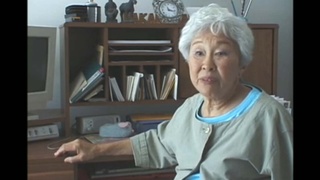Interviews
Sneaking out of the Hastings Park camp during World War II
One of the memories I have of Hastings Park was, was the fact that although there was a fence around Hastings Park, and you weren't allowed to leave the park, you could actually leave the park by just jumping over the fence. And that was very simply done, because it's a great big, one of these big dipper roller coasters, and the roller coaster would go right close to the fence, and you just have to climb yourself up the roller coaster and jump over the fence, which was only about eight feet high. And so you just come right over there, and then you just jump the fence, and you could go out. The problem was to get back in; that was the only difficulty. And so, so you had to sort of sneak back in somehow when you felt, if there's a number of people there, so that you could sort of sneak in with them. And I know a lot of kids used to try to jump out, spend the day in Vancouver and come, sneak in, back into the camp. Because there's no place -- if you got out, that's fine, but where do you go? You look, you're a visible minority, you can't sleep in the park or anything like that because you'd be caught. So what you end up with is you'd have to come back to the camp. And I, I suppose there may have been some cases where people slipped out and never came back, but where would you go? That was the big problem.
Date: July 25 & 26, 2006
Location: Washington, US
Interviewer: Tom Ikeda
Contributed by: Denshō: The Japanese American Legacy Project.
Explore More Videos

Life in camp as teenager
(1926 - 2012) Scholar and professor of anthropology. Leader in the establishment of ethnic studies as an academic discipline

Didn't have rights that whites had
(1922–2014) Political and civil rights activist.

Californians didn't know about evacuation
(1922–2014) Political and civil rights activist.

Conditions of assembly centers
(1922–2014) Political and civil rights activist.

Visit to assembly centers by E. Stanley Jones
(1922–2014) Political and civil rights activist.

Hiding what happened in camp
(1922–2014) Political and civil rights activist.



Camp as a positive thing
(1922–2014) Political and civil rights activist.

Involvement in JACL
(b.1935) American born Japanese. Retired businessman.

Importance of education in achieving redress for incarceration
(1919-2014) Activist for civil rights and redress for World War II incarceration of Japanese Americans.

Her experience as a Japanese-American schoolchild in Oceanside, California, after the bombing of Pearl Harbor
(1924-2018) Artist and playwright.

Finding work in the assembly center
(b.1913) Kibei from California who served in the MIS with Merrill’s Marauders during WWII.

Train ride to Jerome Relocation Center
(b.1913) Kibei from California who served in the MIS with Merrill’s Marauders during WWII.

Evacuation
(b.1909) Nisei from Washington. Incarcerated at Tule Lake and Minidoka during WWII. Resettled in Chicago after WWII
